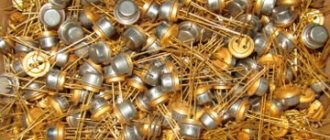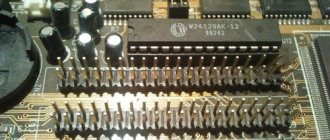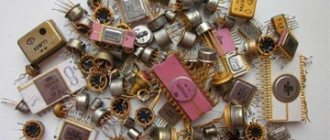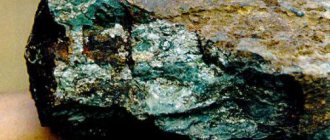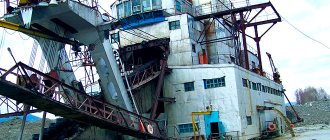Refining is the purification of metal from impurities.
This process consists of a series of sequential processes for separating excess components by physical and chemical means.
Some of the refining methods used in industry can be implemented at home, but sometimes the costs of carrying out the reactions exceed the profit from the resulting noble metal.
In this article we will tell you how to remove and separate gold from radio components and get it out of microcircuits, how to do it safely with your own hands.
What does gold refining mean in jewelry?
So, what is gold refining? This is the name of the metal cleaning process. Not external cleaning, when the product is restored to its former cleanliness and shine. Refining or refining is the removal of additional impurities from gold. This process can also be called refining. Refined gold, like sugar, is a perfectly purified element.
Refining of mined gold at a factory
For example, during mining it is difficult to find perfectly pure gold bars. Most often these are grains mixed with other rocks or just earth. It is also important to know that precious metals, such as gold and silver, are mined from the same ores. Therefore, they are always present in each other’s impurities.
The mined precious metal is processed at the plant, where it is refined.
The result is the production of refined gold - a metal of 999.9 purity.
Accordingly, the gold products used also have additional impurities – other metals. Therefore they need to be refined. So, from jewelry of 585 standard it is quite possible to get 999 standard.
Where to deliver the received material and at what price?
The gold ingot (barrel) obtained as a result of purification most often has insignificant weight. However, even in such quantities it is of interest to buyers.
Advertisements for buying gold can be easily found on the Internet or in local newspapers.
Often, solid metal is purchased by the same companies that buy radio components.
(for example, aluminum or brass) may also be interested in gold
If the buyer is in the same city as the seller, the transaction is completed upon visiting the specified address.
The buyer himself weighs the metal and checks its quality, after which he sets a price. Of course, if possible, it is advisable to check all offers on the market in order to choose the most profitable one. The bullion can be sent to another city by mail, cash on delivery.
Some pawnshops are also ready to accept goods of this kind. To find out at what price the establishment will be willing to purchase gold, contact a pawnshop employee. Another option is to submit an ad yourself . In this case, you just have to wait for a call from a potential buyer.
If you engage in refining on an industrial scale, you should rely on existing laws.
To legally engage in the circulation of precious metals, you need to register as an individual entrepreneur or create an LLC.
When selling gold, focus on its purity and market value.
The price per gram of 999 fine precious metal is set by the Central Bank of Russia . Since 2004, its prices have been continuously rising. The most significant jump was observed in 2021, when the cost exceeded 3 thousand rubles per gram.
Raw materials for refining processing
To obtain refined gold, they work with certain raw materials. These are gold-containing materials:
- Natural mixtures containing precious metal. It can be minerals, rocks and even river sand.
- Scrap gold. Used gold items and elements. For example, jewelry scrap includes earrings, rings, chains, bracelets, pendants, and brooches. Technical – radio engineering waste, radio components, microcircuits. Household scrap - coins, dishes, watches, badges, medals. This also includes some types of bladed weapons (sabers, swords, daggers), souvenirs and antiques.
- Waste after purification of medical alloy. For example, gold plating applied by gilding.
- Lead production concentrates. Lead contains noble metals - gold and silver. To separate them, zinc is used. When heated, it forms a silvery foam, which picks up precious metals and is separated from the lead.
- Rough gold. This type of raw material makes up the largest share subject to refining. This is all the precious metal mined. It goes to processing plants, where it undergoes refining treatment.
Placer gold
As you can see, gold is not only a product of extraction in mines. Noble metal is present in the life of every person: in jewelry and household items.
Methods for purifying refined gold
We have already agreed that refined gold is already pure. It’s so clean that there’s nowhere else to go. But what to do with it now? How to clear it legally, so to speak? I mentioned: it will not be possible to officially sell homemade refined precious metals. Businesses are prohibited from purchasing such products.
It is probably possible to find gray schemes, but firstly, then it will be difficult to get a real price. Secondly, this is a troublesome and unsafe task.
In my opinion, it is easier to give your wealth for official recycling. Your home will be cleaner, and you won’t have to spend money on extra acid (toilet chemicals). Decide for yourself.
Metal cleaning locations
Gold can be refined under special conditions. In what places is this procedure carried out?
Industrial cleaning in enterprises using electrolysis
Refining processing of precious metals is carried out by industrial enterprises specializing in this process. Gold is refined through electrolysis. This process involves passing raw materials through an electric current, as a result of which they are divided into parts. The noble metal is easy to separate from them. There are very few such enterprises. Russian enterprises: Uralelectromed, Krastsvetmet, Kolyma Refinery, Novosibirsk Refinery in Kazakhstan.
Metal cleaning by electrolysis
Equipped laboratories
If refining is carried out on a small scale, then specially equipped laboratories are suitable.
Famous gold deposits
An interesting fact is that 90% of all gold production in the world is provided by the ten largest deposits. The richest and most famous include:
- Muruntau, Uzbekistan. According to preliminary estimates, it is 2.5 times more promising than the next field on the list.
- Grassberg, Indonesia.
- Pueblo Viejo, Dominican Republic.
- Yanacocha in the Cajamarca region, Peru.
- Carlin Trend, Nevada, USA.
- Goldstrike mine, which includes 3 deposits, USA.
- Cortez, Nevada, USA.
- Olympics in Russia, Krasnoyarsk region.
- Veladero mine in Argentina.
- Boddington Quarry, Australia.
Refining methods
There are two ways to purify a precious metal or separate it from impurities:
- chemical;
- electrochemical.
The first method is associated with the interaction of substances, the second – with electric current. Let's consider each of the refining methods.
Chemical methods
There are methods that can be used at home. But some methods are only permissible in laboratories due to increased danger. For example, affinity is carried out using the strongest hydrazine hydrate reagent with the formula N2H4•H2O.
Let us list and analyze how the simplest chemical methods of refining are carried out.
Chemical solution for gold refining
Dry cleaning using the Miller method
This method of refining processing of precious metals is used only by industry, since the chlorine used in refining has a high level of toxicity and corrosivity. Actually, the method itself: all the raw materials are crushed, chlorine gas is passed through it. All base compounds combine with chlorine and evaporate. The fineness of the metal thereby increases. Among the advantages of the Miller method it is worth highlighting:
- low cost;
- use in small areas;
- short time: only a few hours;
- efficiency: you can get 999 gold from scrap.
To purify raw materials, a crucible is needed - this is a fire-resistant container. When gold-containing components begin to melt, chlorine enters the crucible through a special pipe, and then excess impurities are evaporated along with it, the chloride of the noble metal appears on the surface. This method makes it possible to refine gold even from alloys consisting of complex components.
Wet method with aqua regia
The wet method allows you to refine gold from the alloy by dissolving it with certain liquids. For example, one of the popular refining methods is dissolving scrap gold with aqua regia.
For reference: aqua regia is a mixture of concentrated acids: nitric and hydrochloric. By the way, aqua regia is a rare substance that dissolves the noble metal.
What does the refining process look like? The aqua regia, together with the metal and copper sulfate, is heated, resulting in the precipitation of gold. With the right process, the output is 999 pure metal.
Installations and equipment
Several groups of equipment are used in the extraction of precious metals :
- sorting equipment;
- grinding and crushing equipment;
- heat treatment devices;
- containers for electrolytic and chemical processes;
- melting equipment and special equipment for centrifugation.
Sorting of raw materials at the initial stages is done largely manually - on tables, conveyor belts, using simple containers, pallets and boxes. As processing progresses, the share of manual labor decreases.
Repeated sorting of crushed and partially processed raw materials is carried out using sieves , sieves, screens and similar means of mechanization.
Grinding of raw materials is carried out in various crushers , including handicraft and individual production. These plants use impact, cutting, abrasive effects and other technologies to process gold and other metals.
Heat treatment can be carried out manually and in devices that provide the required modes:
- In drying cabinets.
- In furnaces - muffle, electric, cupola furnaces. Furnaces are used for both heat treatment and smelting.
- Firing can be carried out in special individually produced furnaces.
Chemical and electrolytic operations are performed in plastic vessels , less often in metal containers, in glass baths.
Centrifugation equipment is one of the most complex techniques used in the processing of raw materials containing precious metals. Units of branded industrial production are used.
Such equipment is the subject of scientific and engineering research. You can learn more about one of the inventions in this area here.
An organization engaged in this type of activity must register with the State Assay Supervision Inspectorate, which is part of the Ministry of Finance of the Russian Federation.
Collected scrap and waste of precious metals are also subject to accounting .
How to refining microcircuits at home
Despite the complexity of the refining procedure, you can carry it out at home yourself. You can refine both jewelry, household, and technical scrap, the same microcircuits that people usually throw away. The main thing is to create appropriate conditions, properly prepare raw materials and necessary equipment.
Necessary tools, materials and raw materials
What gold-containing parts can be used?
- transistors of the KT series 101, 103, 117, 603, 613;
- microcircuits from old televisions, tape recorders, radios;
- Soviet-made connectors;
- radio tubes containing not only gold, but also silver and platinum: from one lamp you can extract up to 16 grams of the purest precious metal;
- semiconductors, diodes, LEDs, zener diodes, thyristors, capacitors;
- computer parts: connectors, microcircuits in processors, there is a lot of special precious metal in old models;
- coating of Soviet-made metal wristwatches;
- SIM cards.
All this rubbish can lie somewhere in the attic or in the country for years, and the owner will not even suspect how rich he is in gold.
Gold-containing parts
What else is needed besides microcircuits?
- normal whiteness;
- sodium bisulfate.
Or:
- white;
- battery electrolyte;
- table salt.
By mixing these ingredients, you can get hypochlorous acid, which separates the precious metal from the components.
The procedure can also be carried out using iron sulfate. For this you need:
- iron sulfate: it is obtained by dissolving vitriol in water, and rusty nails are also added there;
- sodium chloride;
- hydrochloric acid.
Where is this precious metal found?
Hundreds of tons of gold are used annually in the production of radio components and computer chips. Contacts made of this metal are characterized by high electrical conductivity, they are not subject to oxidation, and therefore are widely used.
Gold
is contained in the following components :
- diodes;
- transistors;
- glass electrodes;
- relay;
- ports;
- jumpers;
- motherboard memory modules.
Note that in practice there may be much less gold in radio components than there should be according to documents (especially in technical products made after 1989).
Conclusion
Recycling of precious metals is one of the very important areas in the field of recycling, some areas of which have not yet been sufficiently developed and are awaiting discovery.
Research and innovation activities in this direction are a relevant sector of business and even politics, because the volume of international transactions with secondary raw materials and their processing is constantly increasing. After reading this article, you learned:
- what organizations and documents control and regulate these processes;
- how precious metals that require processing are collected;
- on technological processes and equipment used for processing raw materials;
- what is made from secondary precious metals, and what is the profitability of such activities.
What it is
Ancient scientists admired gold and believed that it was the best metal of all - the king of metals. Therefore, when alchemists discovered a liquid capable of dissolving it, they called it aqua regia (royal water). In Russian at that time, liquid reagents were called vodka. This is where the name royal vodka comes from.
This is a strong solvent that reacts even with many inert metals (gold, platinum, ruthenium). It has an orange color and a pungent odor of nitrogen dioxide and chlorine.

